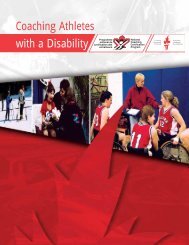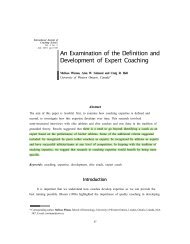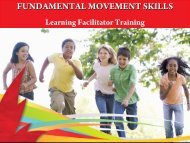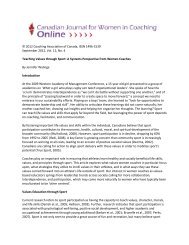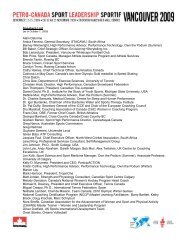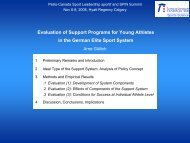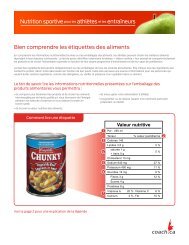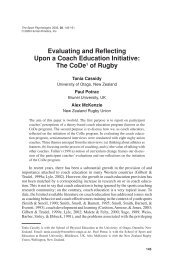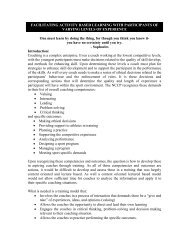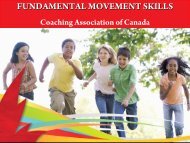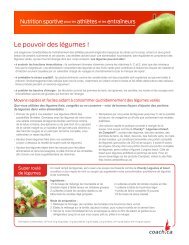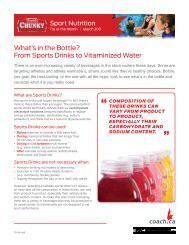LTAD NCCP Integration - Coaching Association of Canada
LTAD NCCP Integration - Coaching Association of Canada
LTAD NCCP Integration - Coaching Association of Canada
Create successful ePaper yourself
Turn your PDF publications into a flip-book with our unique Google optimized e-Paper software.
Paradigm Shifts in Sport<br />
<strong>NCCP</strong> – <strong>LTAD</strong> <strong>Integration</strong><br />
Petro-<strong>Canada</strong> Sport Leadership Conference<br />
Istvan Balyi<br />
National <strong>Coaching</strong> Institute BC<br />
<strong>LTAD</strong> Advisor<br />
sportscoachUK, Republic <strong>of</strong> South Africa,<br />
Kingdom <strong>of</strong> Bahrain, Sport <strong>Canada</strong>
Paradigm Shifts in Sport<br />
• <strong>LTAD</strong><br />
– 10 key Factors<br />
– 10 S’s<br />
• Functional training<br />
– Pre-habilitation or<br />
Rehabilitation<br />
• The Myth <strong>of</strong> the Aerobic Base<br />
in Power Sports<br />
• Transfer <strong>of</strong> Strength<br />
• Speed Training All Year<br />
round<br />
• The Myth <strong>of</strong> Periodization <strong>of</strong><br />
Strength<br />
– Or endurance or speed, or<br />
skill or flexibility<br />
• Overtraining or underrecovery<br />
• Female Athletes and the<br />
Menstrual Cycle<br />
• Chrono or time<br />
– Chrono-nutrition<br />
– Chrono-hydration<br />
• Hygiene<br />
• Flexibility<br />
• Ancillary Capacities<br />
• Periodization<br />
– Junior periodization<br />
• The Diminishing Return<br />
Phase and the Elite Athlete<br />
• Taper
But what is a paradigm<br />
• Thomas Kuhn in his book “The Structure <strong>of</strong> Scientific<br />
Revolutions” (1996) describes paradigms as “the<br />
overall framework <strong>of</strong> basic assumptions used by<br />
scientists when they analyze and interpret their<br />
data.”<br />
• A paradigm can also be thought <strong>of</strong> as a pattern that is<br />
superimposed on the world in order to make sense <strong>of</strong><br />
it.
What is a Paradigm<br />
• When enough significant anomalies have accrued<br />
against a current paradigm, the scientific discipline<br />
is thrown into a state <strong>of</strong> crisis, according to Kuhn.<br />
• During this crisis, new ideas, perhaps ones<br />
previously discarded, are tried.<br />
• Eventually a new paradigm is formed, which gains<br />
its own new followers, and an intellectual "battle"<br />
takes place between the followers <strong>of</strong> the new<br />
paradigm and the hold-outs <strong>of</strong> the old paradigm.
What is a Paradigm<br />
• The approach to athletic training has undergone<br />
radical changes over the last decade.<br />
• These changes are sometimes referred to as<br />
paradigm shifts.<br />
• New paradigms for short and long-term athlete<br />
preparation, planning, and periodisation are<br />
challenging coaches and sport administrators to<br />
rethink and restructure training, competition and<br />
recovery.
What is a Paradigm<br />
• Coaches also use a framework <strong>of</strong> assumptions when<br />
they construct, implement and evaluate athletic<br />
training programs.<br />
• <strong>Coaching</strong> paradigms include assumptions about the<br />
nature <strong>of</strong> athletic training and competition.<br />
• Every coach has his/her paradigm <strong>of</strong> athletic<br />
preparation.
What is a Paradigm<br />
• Coaches <strong>of</strong>ten evaluate the value <strong>of</strong> their coaching<br />
paradigms based on athlete performance.<br />
• If a coaching paradigm has been successful in the<br />
past, there is a tendency for the coach to continue to<br />
use it.<br />
• However, history has shown that past success<br />
doesn’t guarantee future success.
« La définition de la folie, c’est refaire toujours la<br />
même chose en s’attendant à un résultat différent. »<br />
Albert Einstein<br />
“The definition <strong>of</strong> insanity is doing the same<br />
thing over and over again and expecting<br />
different results.”<br />
Albert Einstein
<strong>LTAD</strong> is<br />
• Optimal training, competition<br />
and recovery programming with<br />
relation to biological<br />
development and maturation<br />
• Equal opportunity for<br />
recreation and competition, it<br />
is not an elitist model
Seven<br />
Stages<br />
<strong>of</strong><br />
Long-Term<br />
Athlete<br />
Development<br />
Active Start<br />
FUNdamental<br />
Learning to Train<br />
Training to Train<br />
Training to Compete<br />
Training to Win<br />
Active for Life
<strong>LTAD</strong><br />
is the<br />
border collie<br />
<strong>of</strong><br />
sport system<br />
building !
A Framework for Activity
Cumann Lúthchleas L<br />
Gael – Builds Character
Contents<br />
Foreword<br />
Acknowledgements<br />
Introduction Learn to Train (Under 12)<br />
Strength Training<br />
Speed<br />
Aerobic Training<br />
Flexibility<br />
Mental Training<br />
Hydration and Nutrition<br />
Planning for Games<br />
Lets Go Games<br />
Games Skills Tactical Awareness<br />
Programmes for Development<br />
<strong>Coaching</strong> Skills<br />
Technical Development - Football<br />
Technical Development - Hurling<br />
Warm up<br />
Games for Better Team Play<br />
Code <strong>of</strong> Conduct<br />
Bibliography<br />
4<br />
5<br />
6<br />
21<br />
51<br />
61<br />
64<br />
70<br />
78<br />
84<br />
95<br />
106<br />
113<br />
137<br />
146<br />
197<br />
245<br />
266<br />
283<br />
289<br />
Istvan Balyi<br />
World leading expert on Long Term Player<br />
Development<br />
who described our Fundamentals manual as<br />
an example <strong>of</strong> good practice world wide
<strong>LTAD</strong><br />
• History <strong>of</strong> <strong>LTAD</strong> and a brief review <strong>of</strong> the literature<br />
• 10 Year Rule<br />
• The FUNdamentals - PL<br />
• Specialization<br />
• Developmental Age<br />
• Trainability<br />
• Mental, Cognitive and Emotional Development<br />
• Periodization<br />
• Calendar Planning for Competition<br />
• System Alignment and <strong>Integration</strong><br />
• Kaizen
<strong>Coaching</strong> <strong>LTAD</strong> Models<br />
A brief review
• <strong>LTAD</strong> is based on coaching science<br />
literature and NOT on the acquiring<br />
expertise literature<br />
• However, <strong>LTAD</strong> is supported by the<br />
acquiring expertise literature
Ericsson and Cote<br />
• Very interesting debate<br />
• Deliberate Practice<br />
• Deliberate Play<br />
• Sportscoach UK Athlete Development Pathway<br />
– Active Start<br />
– FUNdamental<br />
– Lear to Train = Learning to Play and Practice
Harsanyi, , (1985)<br />
• Reviewed long-term athlete development<br />
coaching models<br />
E<br />
Junior<br />
Juvenile<br />
Mass sport<br />
“Pyramid”<br />
T2W<br />
T2C<br />
T2T<br />
A4L<br />
L2T<br />
F<br />
AS
Harsanyi, , (1985)<br />
Classical models 1<br />
Usually based on 4 stage models<br />
– Child<br />
– Juvenile<br />
– Junior<br />
– Adult<br />
• Thiessen-<br />
Seibmann(1959)<br />
• Filin (1964)<br />
• Tscheiene (1970)<br />
• Hess (1971)<br />
• Feige (1978)<br />
• Frey (1980)<br />
• Basic<br />
• Intermediate<br />
• Advanced<br />
• Elite
Harsanyi, , (1985)<br />
Classical models 2<br />
• Age independent models<br />
– Martin (1977)<br />
– Nadori (1981)
Harsanyi, , (1985)<br />
Classical models 3<br />
• “Anti” early specialization models<br />
– Matveyev (1957)<br />
– Stemmler (1959)
Contemporary Models<br />
Long-term Structure <strong>of</strong> Training in Athletics<br />
(Thumm,, 1987)<br />
1. Basic training = over-all movement, many-sidedness, overall<br />
sports, rough structure <strong>of</strong> many or all athletic movement<br />
2. Build–Up training = Introduction <strong>of</strong> suitable competitive<br />
events, improvement <strong>of</strong> movement technique, rough<br />
differentiation into sprinting, middle and long distance events,<br />
throwing, jumping or multiple events<br />
3. Top-level training = Mastering <strong>of</strong> the technically finest form<br />
in changing situations, realization <strong>of</strong> conditional, coordination<br />
and psychological potential
Contemporary Models<br />
<strong>LTAD</strong> for Tennis (Holm, 1987)<br />
Four Stage Model<br />
• Pre-Competitive = 6 - 10 years<br />
• Overall = 11 - 14 years<br />
• Specific = 15 – 18 years<br />
• High<br />
Performance = 18+
Contemporary Models<br />
Biomotor Ability / Trainability (Holm, 1987)<br />
Ages: Boys Girls<br />
• Dexterity / Coordination 6 – 10 6 – 10<br />
• Flexibility 13 12<br />
• Speed Agility<br />
– Acceleration run 12 – 14 10 -12<br />
– Slalom run 13 11<br />
– Interval training 15 13<br />
• Strength<br />
– Stage 1 Neural Adaptations 10 – 14 10 – 12<br />
– Stage 2 Hypertrophy 15 – 16 13 – 15<br />
– Stage 3 Max Strength 17 – 18 16 – 17<br />
• Aerobic Capacity 12 - 14 11 – 13<br />
• Aerobic Power 17 – 18 16 - 17
Contemporary Models<br />
Long-term Structure <strong>of</strong> Training in Athletics<br />
(Thumm,, 1987)<br />
• Three stage model Duration years Age<br />
• 1 Basic training 4 - 5 9 – 14<br />
• 2 Build –Up training 3 – 4 15 – 18<br />
• 3 Top-level training 6 – 10 19 +
Contemporary Models<br />
Sanderson (1989)<br />
• Duration Developmental stage<br />
• Initiation 3-4 years Early school years<br />
• Basic training 5-7 Pre-puberty & puberty<br />
• Build up training 3-4 Post puberty<br />
• Systematic<br />
high level training 6-10+ Adulthood<br />
Sanderson U <strong>of</strong> S – reflected on developmental age, and<br />
was part <strong>of</strong> his model
Contemporary Models<br />
Multi Year Planning for Rugby (King, 1992)<br />
• Stage Age Training Age Training Phase<br />
• 1 12 - 13 1 - 2 Preliminary<br />
• 2 14 - 15 3 - 4 Basic Specialization<br />
• 3 16 - 17 5 - 6 Specialization<br />
• 4 18 - 19 7 - 8 Advanced Specialization<br />
• 5 20 - 21 9 - 10 Phase <strong>of</strong> Perfection<br />
• 6 22+ 11 High Performance
Contemporary coaching models<br />
Touretski (1993)<br />
AIS Swimming<br />
• Stage 1 - Preliminary preparation 7-9 (f) 8-10 (m)<br />
• Stage 2 - Initial sport-specific prep 9-10 (f) 10-11 (m)<br />
• Stage 3 – In-depth specialization 12-14 (f) 13-15 (m)<br />
• Stage 4 – Sporting perfection 15-16 (F0 16-19 (m)<br />
(lasts 2 to 8 years)
Contemporary Models<br />
Belov (1995)<br />
Soviet Gymnastics<br />
• Stages<br />
– Initial<br />
– Intermediate<br />
– Final<br />
• Sub-stages<br />
– General preparation<br />
– Initial technical preparation<br />
– Specialized perfection<br />
– Elite (high performance)<br />
– Retirement
• Four stage model:<br />
Contemporary Models<br />
Bompa, 1995<br />
1. Initiation 6 - 10<br />
2. Athletic formation 11 - 14<br />
3. Specialization 15 - 18<br />
4. High performance 19 +
Four Stages Model
Stages <strong>of</strong> Training and Puberty
Platonov (1985) A Five Stage Model<br />
Stages General<br />
Training Load<br />
Complementary<br />
Training Load<br />
Specific<br />
Training Load<br />
Annual<br />
Training Load<br />
(in hours)<br />
Initial 50 45 5 100-250<br />
Basic 35 50 15 350-500<br />
Specific<br />
Base<br />
20 40 40 600-800<br />
Maximization 15 25 60 900-1100<br />
Maintenance 10 25 65 1200-1400
<strong>LTAD</strong> 1<br />
• F. Dick 1985 – periodization article<br />
–Train to Train<br />
–Train to Compete
<strong>LTAD</strong> 2, BC Tennis<br />
•T2T<br />
•T2C<br />
•T2W
<strong>LTAD</strong> 3, BC Tennis<br />
• Early and Late Specialization sports are<br />
distinguished – introduction <strong>of</strong> the<br />
FUNdamental stage<br />
•FUNdamentals<br />
•T2T<br />
•T2C<br />
•T2W
<strong>LTAD</strong> 4 BC<br />
• FUNdamentals 6 – 10 years<br />
•T2T<br />
•T2C<br />
•T2W<br />
• Retirement / Retainment
<strong>LTAD</strong> 5<br />
Research on Physical Literacy and Skill Acquisition<br />
“skill hungry years” or “the golden age <strong>of</strong> skill learning”<br />
• FUNdamentals 6 – 8 F and 6 – 9 M<br />
• Learning to Train 8 – 11 F and 9-12 M<br />
• T2T 11 – 15 F and 12 – 15 M<br />
•T2C<br />
•T2W<br />
• Retirement / Retainment
<strong>LTAD</strong> 6<br />
•Active start<br />
• Active for Life
<strong>LTAD</strong> 6<br />
•Active Start<br />
•FUNdamentals<br />
•L2T<br />
•T2T<br />
•T2C<br />
•T2W<br />
• Active for Life
<strong>LTAD</strong> 6<br />
• Variations<br />
– Terminology (Diving, Triathlon)<br />
– Number <strong>of</strong> stages ( L2C, L2W, Winning for a<br />
Living, etc.)
<strong>LTAD</strong> a Paradigm Shift in Sport<br />
• <strong>Coaching</strong> athletes on developmental age<br />
• Finding solutions for “relative age”<br />
• Training programs are designed on biological markers<br />
• The sensitive periods <strong>of</strong> accelerated adaptation to<br />
training is utilized<br />
• Exclusion to inclusion
FUN …Adapt and Modify Games - GO GAMES<br />
Go Hurling<br />
Go Gaelic<br />
<strong>LTAD</strong><br />
FUNdamentals<br />
( 6 To 8 yrs.)<br />
Learn TO Play 1<br />
(8 To 10 yrs.)<br />
Learn to Play 2<br />
(10 To 12 yrs.)
Traditional Games V Go Games: The Advantages<br />
Turn more on than Off<br />
Traditional Model<br />
Full Games<br />
Full Rules<br />
Go-Games Model<br />
Conditioned Game<br />
Modified Game<br />
‘Outcome’ Focused<br />
‘Processed’ Focused<br />
Substitutions<br />
Everyone Plays<br />
Dominated Better Players All ability levels<br />
Less Skilled Discarded Special Needs<br />
Parent/Mentor Pressures Non-Threatening<br />
Too much competition can<br />
limit early development<br />
Turn them onto Sport<br />
Fun, Fair Play, and<br />
Full Enjoyment will
FUN ….GO GAMES v 15 a Side…The Evidence<br />
Turn more OFF than ON<br />
Traditional Model<br />
Little Ball to Player Contact – Little Action<br />
Turn more ON than OFF<br />
Go-Games Model<br />
More Ball to Player Contact – More Action<br />
Ball and Player out <strong>of</strong> range – Ball and Player in range at all times -<br />
Little Interest and Boredom<br />
More concentration – More Fun<br />
Ratio 15 a side 1: 29 Ratio 7 a side 1:6<br />
More numbers – difficult decision making Less numbers – easier decision<br />
leading to beehive football and hurling making and Better Team Play<br />
Bigger Space – Greater Scanning ability Less Space – Less scanning<br />
- Player needs to use it. Better Spatial Awareness
• Physical Literacy<br />
• A hierarchy, level and number <strong>of</strong> competitions are<br />
designed for all stages (taking into consideration<br />
limitations <strong>of</strong> capabilities before, during and after<br />
puberty<br />
• Random to planned change<br />
• System alignment and integration<br />
– Provincial level<br />
– Federal level<br />
• Kaizen
10 S’s S s <strong>of</strong> <strong>LTAD</strong><br />
• The Original 5 S’s<br />
– Stamina<br />
– Strength<br />
– Speed<br />
– Skill<br />
– Suppleness<br />
– (Trainability)<br />
• The Additional 5 S’s<br />
– Structure/Stature<br />
– (p)Sychology<br />
– Sustenance<br />
– Schooling<br />
– Socio-Cultural
Trainability<br />
• Speed, Skill and Suppleness is based on<br />
Chronological Age<br />
• Stamina and Strength are based on Developmental<br />
Age<br />
• Biological markers for Developmental Age:<br />
– Onset <strong>of</strong> the PHV or Growth Spurt<br />
– PHV (after growth decelerates)<br />
– Onset <strong>of</strong> Menarche
Structure / Stature<br />
Kinanthropometry<br />
(Ross, 2008)<br />
A scientific specialization for human biology and the health pr<strong>of</strong>essions<br />
Identification<br />
Specification<br />
Application<br />
Relevance<br />
Kinanthropometry<br />
for study <strong>of</strong> :<br />
to understand:<br />
Implications for:<br />
movement<br />
Size<br />
Shape<br />
Growth<br />
Exercise<br />
Health<br />
Education<br />
human<br />
Proportion<br />
Composition<br />
Performance<br />
Nutrition<br />
Government<br />
Commerce<br />
measurement<br />
Maturation<br />
Gross<br />
Function<br />
Aim: 1) optimal growth and development <strong>of</strong><br />
all the children <strong>of</strong> all the people 2) health and<br />
vigor <strong>of</strong> adults throughout their life span
www.ltad.ca<br />
Later this year
Age 13 14 13 14
Forthcoming:<br />
Mental Skills for <strong>LTAD</strong> Stages<br />
www.ltad.ca
Operationalizing <strong>LTAD</strong><br />
• Competition Reviews<br />
– Rowing<br />
– Speed Skating<br />
– Rugby<br />
– XCountry skiing<br />
– Swimming<br />
• Athletics<br />
– Annual periodized plans for the T2T, L2C and T2C stages<br />
• Sprints and hurdles<br />
• Distance<br />
• Jumps<br />
• Throws<br />
• Multiple events<br />
• Curling
COMPETITION PLAN FOR CURLING<br />
TWO GAME DAY #1: 8:00 a.m. & 2:30 p.m.<br />
Wake-up<br />
Light aerobic<br />
stretching<br />
Breakfast<br />
Hydrate<br />
Snack<br />
Debrief<br />
Reload<br />
Mental Recovery<br />
Lunch<br />
Napping<br />
Less than<br />
30 mins.<br />
Hydrate<br />
Snack<br />
Mental Recovery<br />
Debrief<br />
Reload<br />
Supper<br />
Relax<br />
Reset<br />
Sleep<br />
5 6 7 8 9 10 11 12 1 2 3 4 5 6 7 8 9 10 11 12<br />
GAME 1 GAME 2<br />
Pre-Competition Routine:<br />
Warm up<br />
Psychological prep.<br />
Hydrate and Snack<br />
Post-Comp. Routine<br />
Cool down<br />
Rehab/ Recovery/Ice<br />
Light Stretch Snack<br />
Recommend leaving<br />
the building<br />
Pre-Competition<br />
Routine:<br />
Warm up<br />
Psychological prep.<br />
Post-Comp. Routine<br />
Cool down<br />
Rehab/ Recovery/Ice<br />
Light Stretch Snack<br />
Can watch 30 min.<br />
Notes:<br />
Snack (reload) within 20 minutes <strong>of</strong> end <strong>of</strong> each Game<br />
Even if you are going for dinner<br />
Dagg-Jackson; Way; Balyi; Comartin;<br />
Parsons; Cox; Farres; 2005
COMPETITION PLAN FOR CURLING<br />
TWO GAME DAY #2: 9:00 a.m. & 7:00 p.m.<br />
Wake-up<br />
Light aerobic<br />
stretching<br />
Breakfast<br />
Hydrate<br />
Snack<br />
Debrief<br />
Reload<br />
Lunch<br />
Mental Recovery<br />
Napping<br />
30 mins.<br />
Wake-up<br />
Light aerobic<br />
Stretching<br />
Go for walk<br />
Supper<br />
Mental Recovery<br />
Debrief<br />
Reload<br />
Hydrate<br />
Snack<br />
Relax<br />
Reset<br />
Sleep<br />
5 6 7 8 9 10 11 12 1 2 3 4 5 6 7 8 9 10 11 12<br />
GAME 1 GAME 2<br />
Pre-Competition Routine:<br />
Warm up<br />
Psychological prep.<br />
Hydrate and Snack<br />
Post-Comp. Routine<br />
Cool down<br />
Rehab/ Recovery/Ice<br />
Light Stretch Snack<br />
Recommend leaving<br />
the building<br />
Pre-Competition<br />
Routine:<br />
Warm up<br />
Psychological prep.<br />
Post-Comp. Routine<br />
Cool down<br />
Rehab/ Recovery/Ice<br />
Light Stretch Snack<br />
Can watch 30 min.<br />
Notes:<br />
Snack (reload) within 20 minutes <strong>of</strong> end <strong>of</strong> each Game<br />
Even if you are going for dinner<br />
Dagg-Jackson; Way; Balyi; Comartin;<br />
Parsons; Cox; Farres; 2005
COMPETITION PLAN FOR CURLING<br />
3 GAME DAY #1 – 9 am; 4 pm; 8 pm<br />
Wake-up<br />
Light aerobic<br />
stretching<br />
Breakfast<br />
Hydrate<br />
Snack<br />
Debrief<br />
Reload<br />
Mental Recovery<br />
Lunch<br />
Napping<br />
30 minutes<br />
Hydrate<br />
Snack<br />
Mental Recovery<br />
Debrief<br />
Reload<br />
Bigger<br />
Snack<br />
Disengagement<br />
Mental cool-down<br />
Sleep<br />
5 6 7 8 9 10 11 12 1 2 3 4 5 6 7 8 9 10 11 12<br />
GAME 1<br />
GAME 2 GAME 3<br />
Pre-Competition Routine:<br />
Warm up<br />
Psychological prep.<br />
Hydrate and Snack<br />
Post-Comp. Routine<br />
Cool down<br />
Rehab/ Recovery/Ice<br />
Light Stretch Snack<br />
Leave the building<br />
Pre-Competition Routine:<br />
Warm up<br />
Psychological prep.<br />
Post-Comp. Routine<br />
Cool down<br />
Rehab/ Recovery/Ice<br />
Light Stretch<br />
Bigger Snack<br />
Notes:<br />
• If the Game is short modify times.<br />
• If the Game goes into extra end again<br />
modifications need to be made.<br />
Abbreviated<br />
Post-Comp. Routine<br />
Cool down<br />
Rehab/ Recovery/Ice<br />
Light Stretch/Snack<br />
Dagg-Jackson; Way; Balyi; Comartin;<br />
Parsons; Cox; Farres; 2005
COMPETITION PLAN FOR CURLING<br />
3 GAME DAY #2 – 8 am; 11:30 pm; 3 pm<br />
Wake-up<br />
Light aerobic<br />
stretching<br />
Debrief<br />
Reload<br />
Mental Recovery<br />
Debrief<br />
Reload<br />
Mental Recovery<br />
Breakfast<br />
Hydrate and snack throughout day - games and breaks<br />
Meal<br />
Travel or Sleep<br />
5 6 7 8 9 10 11 12 1 2 3 4 5 6 7 8 9 10 11 12<br />
GAME 1 GAME 2 GAME 3<br />
Modified<br />
Pre-Competition Routine:<br />
Warm up<br />
Psychological prep.<br />
Hydrate and Snack<br />
Post-Comp. Routine<br />
Cool down<br />
Rehab/ Recovery/Ice<br />
Light Stretch Snack<br />
Leave the building<br />
Post-Comp. Routine<br />
Cool down<br />
Rehab/ Recovery/Ice<br />
Light Stretch/Snack<br />
Notes:<br />
• If the Game is short modify times.<br />
• If the Game goes into extra end again<br />
modifications need to be made.<br />
• Benefits <strong>of</strong> fitness enable coping with this schedule<br />
• Meal evening before is essential<br />
Dagg-Jackson; Way; Balyi; Comartin;<br />
Parsons; Cox; Farres; 2005
<strong>NCCP</strong> and <strong>LTAD</strong> Alignment<br />
• <strong>LTAD</strong> is content<br />
• Not only the stages but the 10 Key Factors and the<br />
10 S’s<br />
• GAA example <strong>of</strong> full integration <strong>of</strong> <strong>LTAD</strong> and<br />
<strong>Coaching</strong> education<br />
• Taekwondo integration
Long-Term Athlete Development<br />
C. Flett, Director, <strong>NCCP</strong>
Performance<br />
Oriented<br />
Athletes/Teams<br />
Participation<br />
Oriented<br />
Sportspeople<br />
Talents<br />
High<br />
Performance<br />
Beginners<br />
Participation<br />
Oriented<br />
7<br />
Master Coach<br />
EQF<br />
Levels<br />
(1- 8)<br />
-<br />
Senior Coach<br />
Coach<br />
National<br />
Levels<br />
3<br />
Apprentice Coach
Draft Long Term Participant Development Pathway<br />
Participation-Oriented<br />
Performance-Oriented<br />
LEARNING &<br />
RE-LEARNING<br />
TO PARTICIPATE<br />
Sustaining<br />
Participation<br />
Developing<br />
Participation<br />
Sustaining<br />
Performance<br />
Developing<br />
Performance Podium<br />
Development<br />
Talent<br />
Talent Development<br />
LEARNING TO PLAY AND PRACTICE<br />
EARLY<br />
SPEC.<br />
FUNDAMENTALS<br />
SPORTS<br />
ACTIVE START
Long Term Coach Development Model
Questions
Definitions<br />
• Growth refers to observable step-by-step changes in<br />
quantity, “measurable changes in body size, for<br />
example, height, weight, fatness.” (Malina, 1986)<br />
• Maturation refers to “qualitative system changes,<br />
both structural and functional in nature, in the<br />
organism’s progress toward maturity, for example,<br />
the change <strong>of</strong> cartilage to bone in the skeleton.”<br />
(Tihanyi, 1990)
• Development refers to “the<br />
interrelationship between growth<br />
and maturation in relation to the<br />
passage <strong>of</strong> time.<br />
• The concept <strong>of</strong> development also<br />
includes the social, emotional,<br />
intellectual and motor realms <strong>of</strong> the<br />
child.” (Tihanyi, 1990)
• Chronological age refers to “the number <strong>of</strong><br />
years and days elapsed since birth” (Haywood,<br />
1993)<br />
• Skeletal age refers to the maturity <strong>of</strong> the<br />
skeleton “determined by the degree <strong>of</strong><br />
ossification <strong>of</strong> the bone structure.” (Haywood,<br />
1993)
• Critical periods <strong>of</strong> development: A<br />
critical period refers to a point in the<br />
development <strong>of</strong> a specific behaviour when<br />
experience or training has an optimal<br />
effect on development. The same<br />
experience, introduced at an earlier or<br />
later time, has no effect on, or retards<br />
later skill acquisition. (Zaichkowsky,<br />
Zaichowsky and Martinek, 1980)
Trainability<br />
• Malina and Bouchard (1991) defined<br />
trainability as “the responsiveness <strong>of</strong><br />
developing individuals at different stages<br />
<strong>of</strong> growth and maturation to the training<br />
stimulus.”.
• Malina and Bouchard (1991) also referred to<br />
“readiness and critical periods” <strong>of</strong> trainability during<br />
growth and development <strong>of</strong> young athletes, thus the<br />
stimulus have to be timed<br />
to achieve optimum adaptation with regard to motor<br />
skills, muscular and/or aerobic power .
• Adaptation refers to a stimuli or a series <strong>of</strong><br />
stimuli which induces functional and/or<br />
morphological changes in the organism.<br />
Naturally, the level or degree <strong>of</strong> adaptation<br />
is dependent on the genetical endowment <strong>of</strong><br />
an individual. However, the general trends or<br />
patterns <strong>of</strong> adaptation are identified by<br />
physiological research and the facts and<br />
guidelines <strong>of</strong> the different adaptation<br />
processes, such as adaptation to muscular<br />
endurance or maximum strength, are clearly<br />
delineated.<br />
• Diagnostics before and after maturation<br />
• Moving scales during PHV



